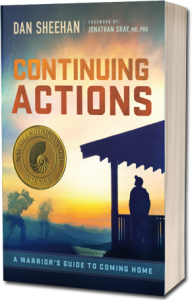Continuing Actions Chapter 7
EMOTIONS, SHIT.
“Narrative can transform involuntary reexperiencing of traumatic events into memory of the events, thereby reestablishing authority over memory.Forgetting combat trauma is not a legitimate goal of treatment.” —Jonathan Shay, Achilles in Vietnam, p.192
IF YOU HAVE ESTABLISHED your own safety and sobriety, either through self-, buddy- or corpsman-aid, then you are ready to move forward. The next challenge you must overcome is figuring out how to reestablish authority over your own memory because, even if you don’t remember these experiences, you can’t forget them.
Great, that’s super helpful. So how the hell are we supposed to go about making sense of something we can’t even consciously remember?
By telling our own true narratives.
Sounds deceptively easy. But in reality, understanding our experiences thoroughly enough to be able to communicate them to another person requires a lot of hard work. It is this hard work, unpacking the emotions generated by our experiences, that creates a pathway through the emotional challenges of the warrior’s return.
We’re at a disadvantage with these challenges right from the start, mainly because we don’t want to admit we even feel emotions, let alone that some are so powerful as to overwhelm us. There was something almost heroic in facing the physical challenges. But emotional ones? How the hell am I supposed to make that sound tough?
I’m not. So get over it. This shit is real, it can really destroy you and your family, and you have to get over this hang-up about “emotions” and move on. This chapter will explore the reality of the warrior’s emotions and the dangers of ignoring them. Emotions are part of being human, even for tough guys and gals. It’s time we learned how to deal with them.
WHY?
Why should we go through all the trouble to unpack and process painful memories and emotions? Why can’t we just leave them packed away in the dark corners of our minds and ignore them? Stack them up, lock the door, and put HAZMAT signs all over. Why can’t we just let sleeping dogs lie?
Because they’re not sleeping.
Remember the chasm formed by compartmentalization? The one created when our unconscious mind experienced the full brunt of our emotional reactions in real time while our conscious mind was protected? This chasm, created by the unequal experience of intense emotions, does not lie dormant. Until we close it, this chasm will make us uncertain of our emotional responses.
How many times have you expected to feel one emotion— only to get waylaid by another? This is the result of the split between our conscious and unconscious minds and leads us to distrust our own emotional stability. Unruly, unpredictable emotions follow us home from combat and, through us, impact our families. These weird flashes of intense emotions are often the most visible indication that combat changed us. But because we don’t understand them, we grow ashamed of their existence. They become something we must hide, must suppress, must ignore—or else admit to something that feels like weakness.
But even if we successfully compartmentalize our emotions, we can’t catch them all. Experiencing one emotion might allow another, totally unrelated, one to sneak out. A moment of parental bliss can be the Trojan horse that allows hidden memories of Iraqi children begging for MRE packets to escape. Who wants to remember the guilt felt at ignoring their pleas for food or annoyance when they pressed too close to the Hummer? Maybe that packet of hard candy didn’t have to be thrown so hard to drive them back. What if somebody hit my kid like that? . . .
The reality is, we can’t pick and choose what emotions to cut off to protect ourselves from these flashes—we have to control them all. If we revert to compartmentalization, we must put the tourniquet back on and crank it down tight. In doing so we choose to deny all emotions rather than suffer unpredictable flashes of anger, sadness, fear, or guilt. We grow cold, emotionally distant, and always on guard against a part of us we neither trust nor understand.
This is the easy road to take. All we have to do is revert to what worked in combat and tighten down control of our emotions. But the cost of wearing that tourniquet is a life of ruined relationships with friends, lovers, spouses, and children. It cuts off not only painful emotions and memories but the good ones as well. We deny ourselves opportunities for true joy and happiness—even the basic experience of being alive—for the remainder of our time on earth. We become shells of people at that point, incapable of creating and maintaining the emotional connections essential for human happiness.
“Because post-traumatic symptoms are so persistent and so wide-ranging, they may be mistaken for enduring characteristics of the victim’s personality. This is a costly error, for the person with unrecognized post-traumatic stress disorder is condemned to a diminished life, tormented by memory and bounded by helplessness and fear.” (Herman, p.49)
Is this the burden we, and our families, must bear? Must our families forever hide their pain and confusion at our actions behind a shield of “We don’t know—he was never the same after the war”? Are we “condemned to a diminished life” where neither we, nor anybody else, can understand why we react the way we do?
No. There is another way.
DIFFERENT BATTLE, DIFFERENT TACTICS
If continued compartmentalization maintains and possibly widens the chasm, then de-compartmentalization is the key to closing it. This means that what we stuffed away and ignored in combat must be pulled out and experienced now. To accomplish this we must change our tactics: Instead of closing down, we must open up, instead of tightening the tourniquet, we must take it off. The dark chambers in our minds must be opened, the contents within examined, and the formerly trapped emotions given the chance to run their course. We must allow ourselves to consciously experience now what we couldn’t then.
Roy Grinker and John Spiegel were psychiatrists who worked extensively with soldiers during and after WWII. During that time, hypnosis and narcosynthesis (the use of sodium amytal to induce an altered state) were being used to gain access to veterans’ hidden traumatic memories. While those methods were effective in retrieving traumatic memories, they did not effectively reduce the symptoms of what would later be labeled PTSD.
“Grinker and Spiegel observed likewise that treatment would not succeed if the memories retrieved and discharged under the influence of sodium amytal were not integrated into consciousness. The effect of combat, they argued, “is not like the writing on a slate that can be erased, leaving the slate as it was before. Combat leaves a lasting impression on men’s minds, changing them as radically as any crucial experience through which they live.”” (Herman, p.26)
It’s not easy to uncover these memories. Our walls of compartmentalization are solidly built, and we often don’t even know what’s hidden behind them. To top it off, we place great value on those walls because they protected us in combat. Let’s face it—we liked being able to focus on our mission amid chaos. We took pride in the fact, rightfully so, that others could count on us in a crisis. Those walls made us feel good on some level, almost indestructible, and we are loathe to discard the protection they offer. But that protection has served its purpose and is no longer needed. Clinging to it like a security blanket only traps us in the past.
If you’ve quieted the physical aftereffects of combat and are not actively destroying yourself with drugs, alcohol, or unmitigated risk-taking, then you’ve achieved the goal of the first stage of healing: Safety. This is a good start but it’s time to get moving again.
SELF-AID: THE BACKBONE OF
YOUR STRATEGY TO MOVE FORWARD
Just as they worked for overcoming the physical challenges, the concepts of self-, buddy-, and corpsman-aid apply to the challenges of uncovering, understanding, and communicating the emotional reactions to combat as well. Various counseling methods offered by the VA make up the corpsman-aid level of support. Even if you do immediately talk to a counselor, though, remember that he or she is not the Happiness Fairy. You bear the ultimate responsibility for healing your wounds and must go into counseling willing to do the hard work required for it to be successful.
Regardless of whether you work with a counselor or not, you must develop and apply your own self-aid efforts to work through your emotional backlog. The external support offered by buddy- and corpsman-aid options should be considered supporting arms. You can call on them for assistance, like close air support or artillery, but don’t expect them to win the battle for you. External support is effective only if there is an underlying plan to support. The simple fact is, you must be fully dedicated to emotional self-aid before any amount of buddy- or corpsman-aid can help.
The self-aid plan I’m going to lay out provides a means to dig these memories and emotions out of their hidden positions. But following it is not going to be easy or comfortable. It will demand personal courage on your part because it cannot be done from inside a bunker. You must abandon your protection, break down the walls of compartmentalization, and share what you’ve been through. There’s simply no other way.
IMMEDIATE SHARING—IT JUST DOESN’T WORK
When I first got home from Iraq, I attempted to tell people what it had been like. Family, friends, acquaintances, well-wishers on the street—it didn’t really matter who. I just wanted them to understand what I’d been through. I’d been to a realm of human experience that was terrifying, fascinatingly fantastic, and undeniably real. I’d done things that had profound impacts on me and I wanted people to know what they were. Problem was, I didn’t know what they were myself.
I hadn’t done any of the legwork required to understand what I’d been through, and my inept attempts to explain my experiences frustrated the hell out of me. I couldn’t find the words to adequately describe the intense reactions I’d had in combat. It was too cumbersome to try and explain how I could simultaneously feel pride and horror at killing another human being. Or how the crushing fatigue of eighteen hours in the cockpit could be erased by a moment of terror—only to come crashing back seconds later. I was trying to tell people things I’d hidden behind my walls of compartmentalization, but I didn’t really know what they were.
I found myself struggling for words, grasping at half-formed analogies, and was constantly interrupted by the realization my words sounded like a weak Hollywood script. The blank stares, polite nods of encouragement, and general statements of thanks told me the person I was talking to had no clue what I was trying to say. So I stopped trying.
This is not uncommon. Among veterans I’ve talked to, it seems there is a period of time when most of us try to share what we experienced—only to have the attempts end in failure. Instead of rebounding and trying a different approach, though, we usually quit right there. We feel a vague sense of shame that we even tried to share our experiences and a sharper pang of confusion when we realize we were unable to do so.
These initial failed attempts at communication reinforce the idea that we should just bottle it all back up and stuff it away. We convince ourselves there is no point trying to share because nobody could possibly understand anyway. But there is a point, and a very tangible benefit to our families and ourselves if we can share this information. It’s not going to be as easy as just blurting it out, though. We have to close the chasm first.
THE FIRST STEP IS BRIDGING THE GAP
Compartmentalization created the chasm between your conscious and unconscious minds. To close it you must bring your conscious mind up to speed. This requires you to open hidden compartments, release the intense emotions trapped inside, and gain perspective by being able to see the entirety of your experiences. The eventual goal is to be able to effectively communicate what you’ve been through to another person, but that is impossible if you don’t first understand it yourself.
To become conscious of the information you’ll eventually need to share, you must first excavate it from hidden compartments in your mind. Good counselors can help you do this, but there is a lot you can do yourself. Self-aid for this stage demands a deeper, more multifaceted process of self-discovery than verbal communication normally offers. For me, this situation required writing.
Writing offers us the ability to lay everything out before us, edit, cut out, add, and work through layers of often conflicting emotions. Some of these emotions are loud and obscure the quieter, more-nuanced emotions that feed our vague sense of unease. But by moving them outside our heads and onto paper, we can quiet the boisterous emotions and become aware of what lies beneath them. Writing is also slower than speaking and gives us the ability to remain inside a memory long enough for it to fully bloom in our comprehension. This forces us to slow down and prevents us from skipping over important events we might otherwise unconsciously avoid. And if we can get to the point where what we’ve written is an accurate portrayal of how we truly felt during those experiences, then our conscious mind will have been brought up to speed along the way. The writing process will have steeped it in the same emotions the unconscious was exposed to in combat, and the chasm will be closed.
I’d been working on my first book for several years before I saw how writing had done this for me. I did not choose writing as part of any master plan, just as an honest desire to get to the bottom of what was bothering me. I eventually did just that, but the road I took held many unneeded twists and turns. When those are removed, the process becomes much more straightforward—and the chances of success that much greater.
OPS PAUSE
Hold where you are. No plan survives first contact with the enemy and adjustments are inevitable. There is danger involved with excavating the emotions and reactions of our past without first having the right support structure in place. Mental health professionals are adamant that trying to dig them up before we have established a framework for safety and support is dangerous. This is not a test to see who can pull out the nastiest memory the quickest or to see who’s strong enough to handle it. Some memories need to be treated like the HAZMAT they are.
This is a good point to stop and take an honest self-assessment. Just like you’d check yourself for broken bones before gathering your parachute and trotting off the drop zone, now’s the time to evaluate if you’re ready to move ahead—or if it’s time to call in the Doc.
Are you stable? Do you have healthy, supportive relationships with friends and family? Is the physical activity you chose sponging up the leftover physiological reactions to combat? Remember, this is not something you do once and then you’re done with it. You’ll need to continue to use this activity in order to gain the quiet periods in which to address the deeper, more nuanced emotional reactions to combat. These quiet periods are essential to establishing your safety and sobriety and must be in place before you can progress to the next level of healing.
SPEED IS NOT OF THE ESSENCE
If you’re not there yet, don’t rush it. Take advantage of this pause in operations to consolidate your gains in the form of personal safety and sobriety before moving forward on your journey. This includes assessing your relationships and making sure they are healthy and supportive. More than one veteran has been sidetracked by relationships with people who encouraged stagnation by actively working against their efforts to heal. Have a buddy who just wants to get wrecked every night? Or a romantic partner who demands that you “get over” whatever is bothering you so they won’t be inconvenienced? Recognize these relationships as dangerous and insulate yourself from them as needed. Not every- body who knew you before combat will be capable of helping you afterwards.
The dangers of advancing into painful and confusing memories without first creating a secure environment may make it worthwhile for you to talk to a mental health professional—even online or through a 24-hour hotline—before driving on. Doing this can help you accurately assess how good your support structure is and whether you’re ready to move forward.
Just accepting the challenges of coming home has put you on the right path. This path is neither a straight line nor easy to follow, however, and requires careful self-discipline and awareness of potential threats to travel it safely. Luckily, this race is not against the clock.
In this race, progress is ensured by the absence of stagnation. The distance each of us must travel is different, and some journeys are significantly longer than others. How long it takes is irrelevant. Any movement forward, no matter how small, puts you closer to really coming home. It may seem like slow going, but as long as you’ve established your own safety, sobriety, and self-care, time is on your side.
By refusing to stagnate, you have already taken the hardest step in any journey—the first one. So don’t worry about the clock. Things will change, they will get better, and you will move forward—and the next chapters will show you how.



